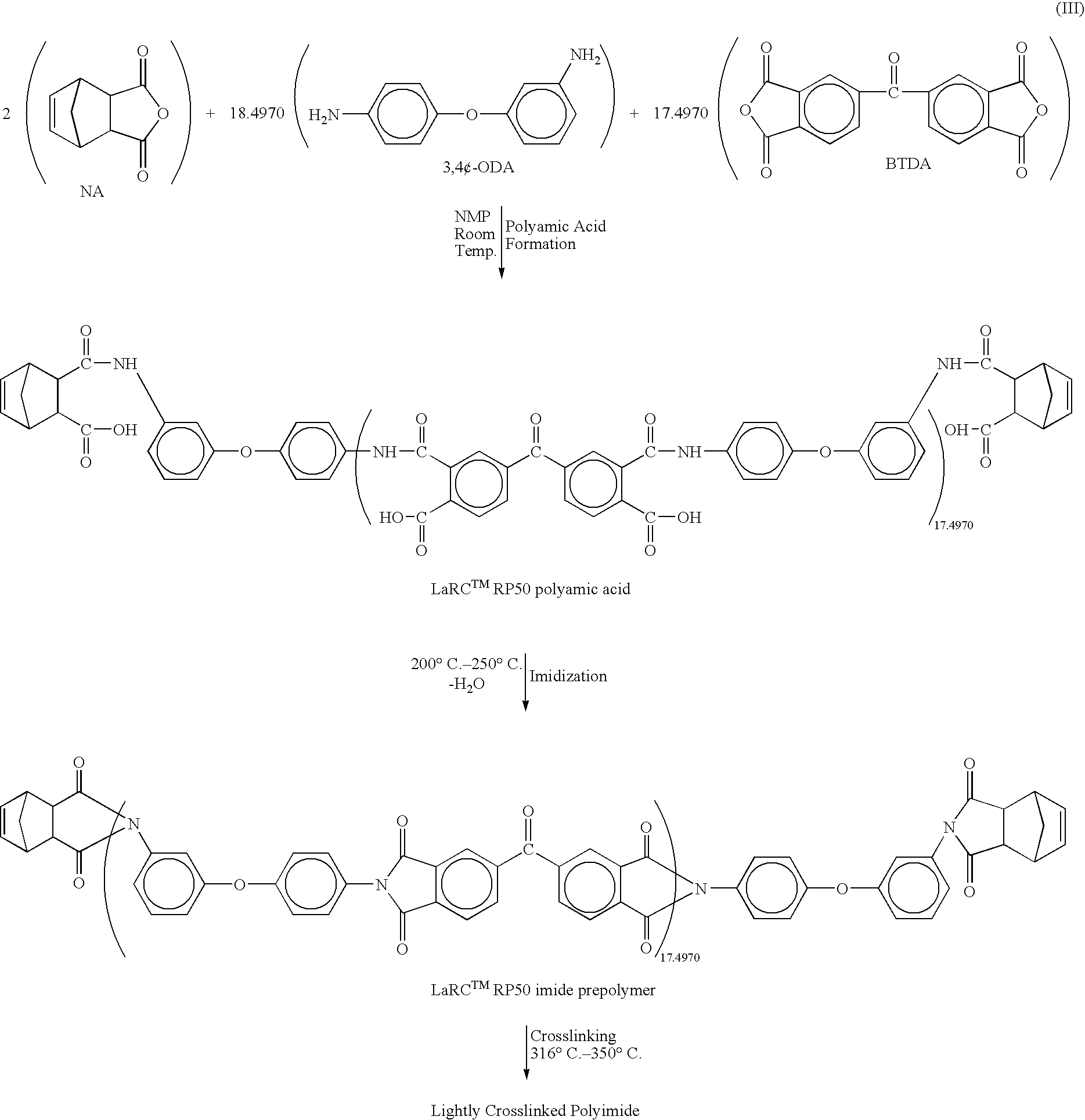Heat, moisture, and chemical resistant polyimide compositions and methods for making and using them
- Summary
- Abstract
- Description
- Claims
- Application Information
AI Technical Summary
Benefits of technology
Problems solved by technology
Method used
Image
Examples
example 2
Preparation of a LARC.TM.RP 50 Polyamic Acid in a Dual Solvent System of NMP and o-dichlorobenzene (DCB).
3,4'-ODA (591.9040 g, 2.9560 mole), NMP (2318.7500 g, or 2244.6757 ml) and DCB (2318.7500 g or 1776.1394 ml) were added to a 12-liter, 3-necked round bottom flask equipped with a mechanical stirrer, condenser and nitrogen inlet. The solid dissolved and yielded a light brown solution, which was stirred for 1.5 hours at room temperature, followed by the addition of BTDA (901.4444 g, 2.7995 mole). The stirring continued for 16 hours and then NA (52.4800 g, 0.3200 mole) was added. The reaction was stirred for 2 hours, which resulted in a brown viscous polyamic acid solution with an inherent viscosity of 0.99 dL / g, determined at an 0.5% solid solution at 25.degree. C. in NMP.
example 3
Preparation of a LARC.TM.RP 50 Polyamic Acid in a Dual Solvent System of NMP and Chloroform.
3,4'-ODA (591.9040 g, 2.9560 mole), NMP (2318.7500 g or 2244.6757 ml) and Chloroform (2318.7500 g or 1547.4323 ml) were added to a 12-liter, 3-necked round bottom flask equipped with a mechanical stirrer, condenser and nitrogen inlet. After it was stirred at room temperature for 1.5 hrs, BTDA (901.4444 g, 2.7995 mole) was added. The stirring continued for 16 additional hours and then NA (52.4800 g, 0.3200 mole) was added. The reaction was stirred for 2 more hours, which resulted in a brown, viscous polyamic acid solution with an inherent viscosity of 0.87 dL / g in NMP at 25.degree. C.
example 4
Preparation of a LARC.TM.RP 50 Polyamic Acid Powder.
About 500 g of the polyamic acid solution prepared in Example 1 was poured in a small stream into a large household blender, which was two-thirds full of distilled water. The precipitated off-white solid was filtered, and then reslurried in distilled water in the blender, refiltered and reslurried in warm methanol, then refiltered and dried at room temperature for 3 days.
PUM
| Property | Measurement | Unit |
|---|---|---|
| Temperature | aaaaa | aaaaa |
| Percent by mass | aaaaa | aaaaa |
| Angle | aaaaa | aaaaa |
Abstract
Description
Claims
Application Information
 Login to View More
Login to View More - R&D
- Intellectual Property
- Life Sciences
- Materials
- Tech Scout
- Unparalleled Data Quality
- Higher Quality Content
- 60% Fewer Hallucinations
Browse by: Latest US Patents, China's latest patents, Technical Efficacy Thesaurus, Application Domain, Technology Topic, Popular Technical Reports.
© 2025 PatSnap. All rights reserved.Legal|Privacy policy|Modern Slavery Act Transparency Statement|Sitemap|About US| Contact US: help@patsnap.com



